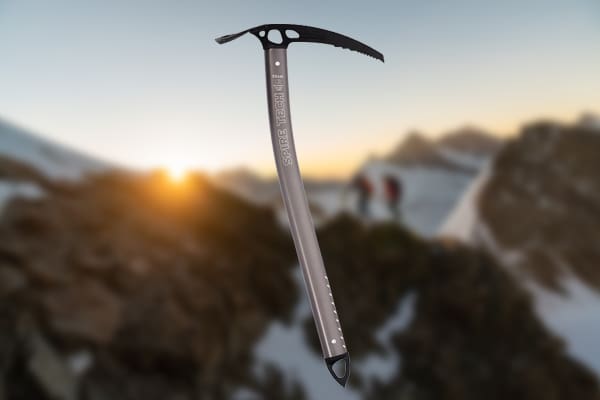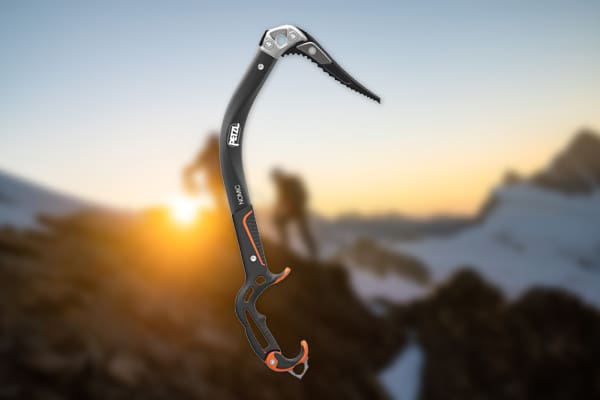Pimples serve as a belay device and as a walking aid. But not all ice ax is the same - completely different equipment is used on light full-speed tours than ice climbing. We take a closer look at the most important differences.
A contribution by Fabian Reichle - Bächli Bergsport
Pimples have always been part of modern mountaineering. In the past, the wooden walking aids for alpine terrain were primarily long - usually around 80cm - with a simple point and pick. Over the decades, the archaic devices became lighter, smaller and more technical.
Modern pimples are designed for different physical properties as well as different uses.
Modern pimples are designed for different physical properties as well as different uses. A distinction is primarily made between two different categories: the all-round and steep ax.

All-round ax
It is the all-rounder and is used on easy to moderately difficult terrain. As a walking aid, it is used on glacier treks and classic high-altitude tours. As a rule, the shaft is straight or at least slightly curved. The former shape is ideal for flat terrain, the latter for steeper passages. The pick of the all-rounder is mostly straight to slightly rounded and not sharpened, as it ultimately only has to be knocked into the ice to a limited extent. The counterpart is a sharp point, the so-called pimple thorn, which gives enough grip on glaciers - the ideal walking aid.
The pick of the all-round pick is mostly straight to slightly rounded and not sharpened
The material also plays a decisive role. Nowadays, the shaft is usually made of aluminum and the head and tip are made of steel. A pimple puts weight on the backpack and ultimately in the hand. There are ultra-light models that are particularly worthwhile for high-altitude ski tours with little use of pimples.
You can determine the appropriate length of such a pimple by holding it loosely in your hand by the pimple head so that it hangs down parallel to your leg. The end should be about the middle of the lower leg or at the level of the end of the mountain boots. If you go on tour with an ax that is too long, you risk an uncomfortable and ultimately unstable position in steep sections and cross passages.
The end should be about the middle of the lower leg or at the level of the end of the mountain boots.
Steep ax
When walking becomes climbing, a steep ax is part of the standard equipment. The most obvious difference to the all-round ax is the strongly curved shaft. If it goes into steep or even overhanging terrain, this helps to save energy. In addition, the pick is sharpened, pulled down and provided with sharp teeth so that the pimple can be optimally hit into the ice. Steep axes are usually shorter, but heavier than their touring counterparts. This enables a greater impact force.
Roughly speaking: the all-round ax is used as a support when walking, the steep ice device for striking and climbing.
What else to watch out for: Norms
In the past, pimples were divided into so-called B- and T-shafts. According to the new UIAA standard, a distinction is made between type 1 (basic ice tools, basic type) and type 2 (technical ice tools, technical type). Type 2 pimples must be marked with a "T", type 1 pimples are not required to be marked. At most, the latter are still marked with a "B". Type 2 picks have to withstand higher requirements than type 1. For easy high-speed tours, type 1 picks are sufficient, for more demanding projects and anchoring in the snow, on the other hand, a type 2 model should be selected.
According to the new UIAA standard, a distinction is made between type 1 and type 2.
Incidentally, the use of hand straps on ice ax is now discouraged, as switching from one hand to the other on a zigzag ascent is tedious and time-consuming. In addition, in the event of a fall, the pimple represents an additional risk of injury if it is attached to the body by the hand strap.
And while we are already with the handling: Many pimples have a partially rubberized shaft for a better grip. If this is not the case, you can help yourself with tape.
This is how you care for your pimple
Even if pimples are made of sturdy materials, they are not immune to wear and tear - especially not because the devices can be subjected to heavy loads. The first credo is to avoid (fly) rust. To do this, simply rub the pimple dry with a cloth after use and store it in a non-humid place.
Point, pick and thorn will inevitably come into contact with rocks, and accordingly one will be able to observe the wear and tear of the metal. Slight signs of wear can be removed with a file, wire brush and fine sandpaper. Electric angle grinders and the like should be left behind, as they can easily heat the metal of the pick, which affects the strength of the material. The motto is “as much as necessary and as little as possible.
That might interest you
- Crampons: You should know these three systems
- Sports / GPS watches: In tune with the times
- Robust companion: the Trad 30 Dry climbing backpack from Ortovox
About Bächli mountain sports
Bächli mountain sports is the leading Swiss specialist shop for climbing, mountaineering, expeditions, hiking, ski touring and snowshoeing. At currently 13 locations in Switzerland, Bächli Bergsport offers its customers expert advice and high-quality service. Published on LACRUX Bächli mountain sports periodically exciting contributions to the topics climbing, bouldering and mountaineering.
+ + +
Credits: Text Fabian Reichle from Bächli mountain sports



